Kabocha squash soup is easy to make, earning its place as a perfect fall soup recipe. It’s creamy, has a hint of nutmeg, and goes great with crusty bread. You can also easily adapt it vegetarian or lactose-free. Just a few ingredients, and you’ve got a comforting dish!
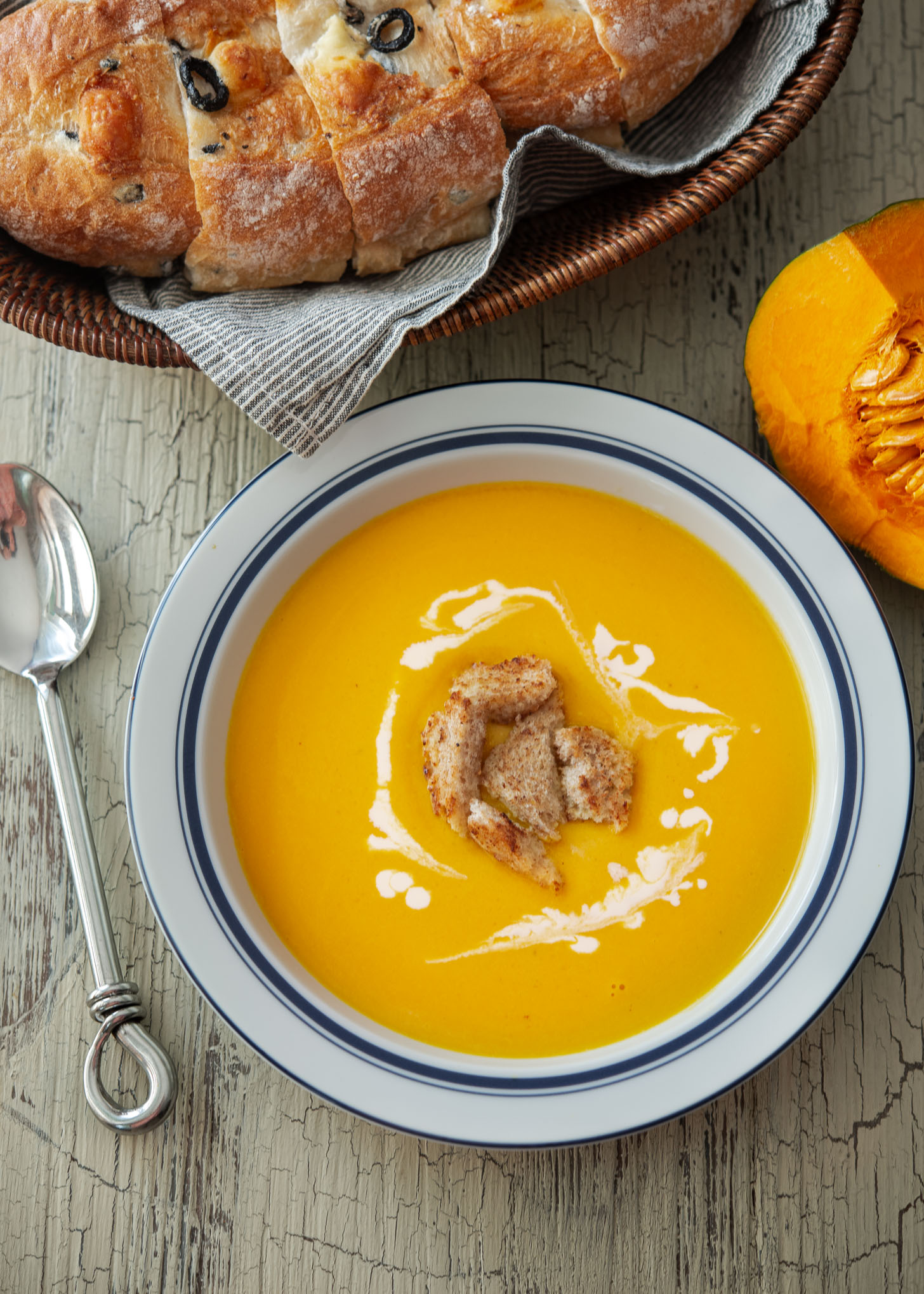

Oh, fall! It’s the season when pumpkins and squashes are all over, from local grocery stores to roadside farmers markets. There’s something special about fall, with its cool, crisp air that just makes you crave a warm bowl of pumpkin soup.
But you know what’s even better than regular pumpkin soup? Soup made with Kabocha squash, also known as Japanese pumpkin!
You’ve gotta try a bowl of this golden Kabocha squash soup; it’s simply delicious. Plus, with this super easy recipe, you’ll whip up a creamy, comforting soup in no time.
Trust me, it’s gonna win your soup-loving heart in a flash!
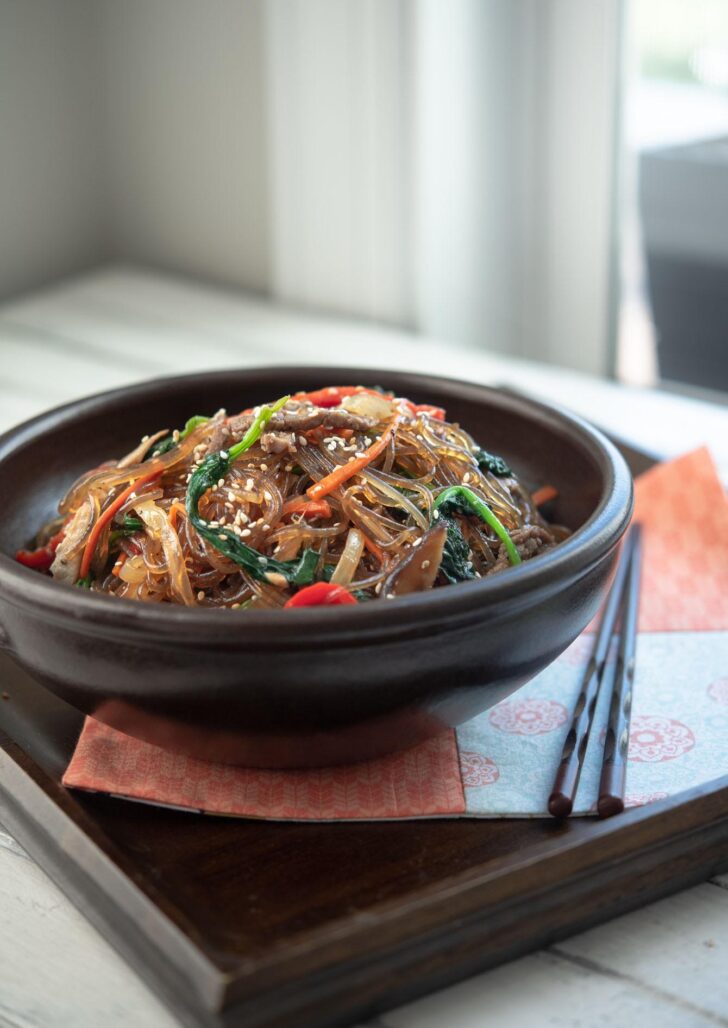

Get new recipes via email:
What is Kabocha?
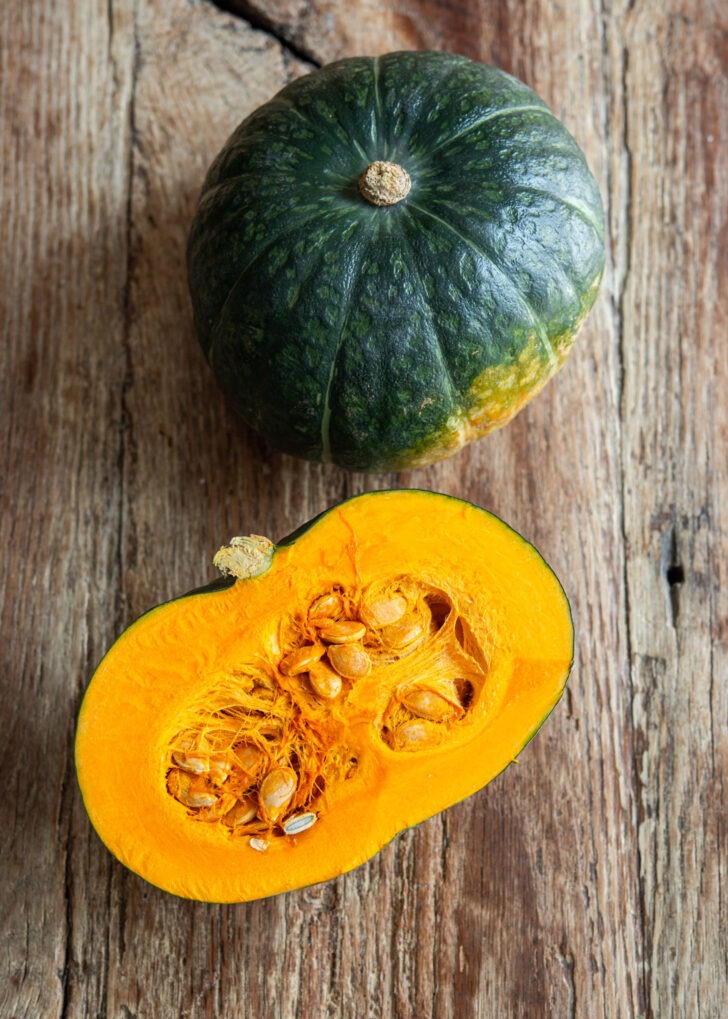

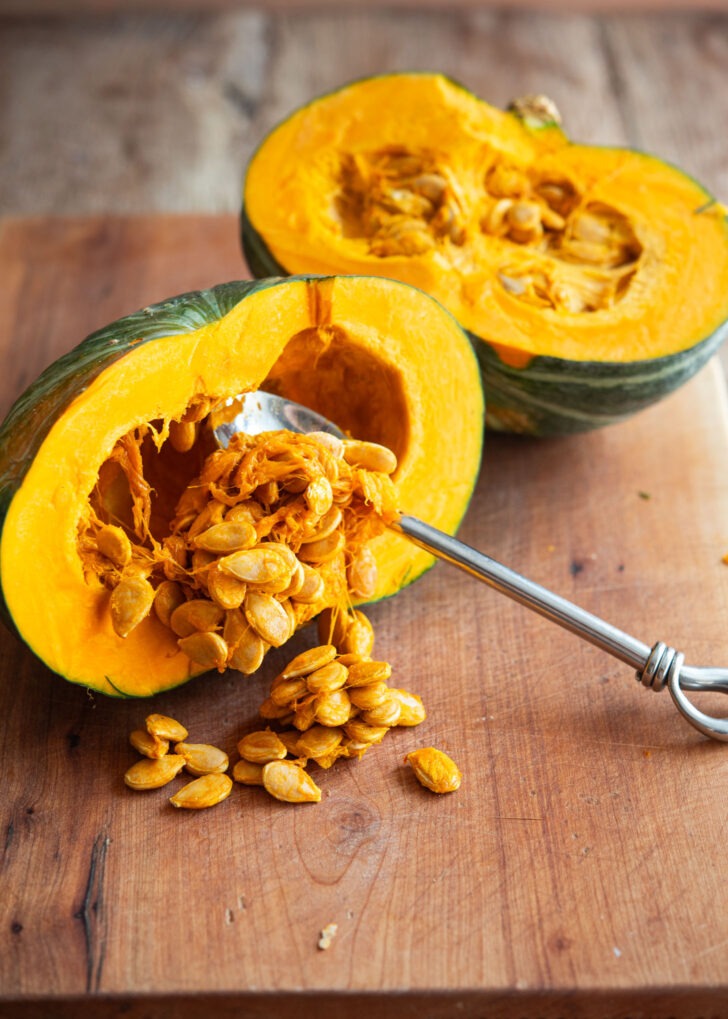

Kabocha, often referred to as an Asian pumpkin or Japanese pumpkin, is a type of winter squash. It’s commonly called kabocha squash, or simply, kabocha. It’s a well known ingredient for Japanese cuisine.
Kabocha has a green, sturdy exterior with streaks of white or pale green. It might remind you of a small pumpkin or a large acorn in shape.
What sets kabocha apart from other pumpkins or winter squash varieties is its unique emerald skin, which becomes delightfully soft and edible after cooking, locking in all the nutritious benefits. Check out my kabocha squash salad recipe to see it in action!
When it comes to the inside, it’s got a bright orange flesh – a popular choice for soup recipes. Taste-wise, it’s a winner! Check out my Korean pumpkin porridge recipe for a flavor twist.
What does kabocha sqush taste like?
Kabocha squash has a sweet, nutty flavor, similar to a cross between a pumpkin and a sweet potato, but with a richer, creamier texture when cooked. Its unique taste is sweeter than butternut squash yet not as sugary as a sweet potato, making it a versatile favorite in many dishes.
Health Benefits
Kabocha isn’t just tasty; it’s packed with nutrients. It’s a fantastic source of beta-carotene, which your body converts into vitamin A.
This helps with vision, immune function, and skin health. It’s also rich in vitamin C, some B vitamins, fiber, and minerals like iron and potassium. Plus, it’s low in calories but can make you feel full—great for managing weight!
There are many kabocha recipes abound, and this kabocha soup recipe is a nourishing treat for your well-being.
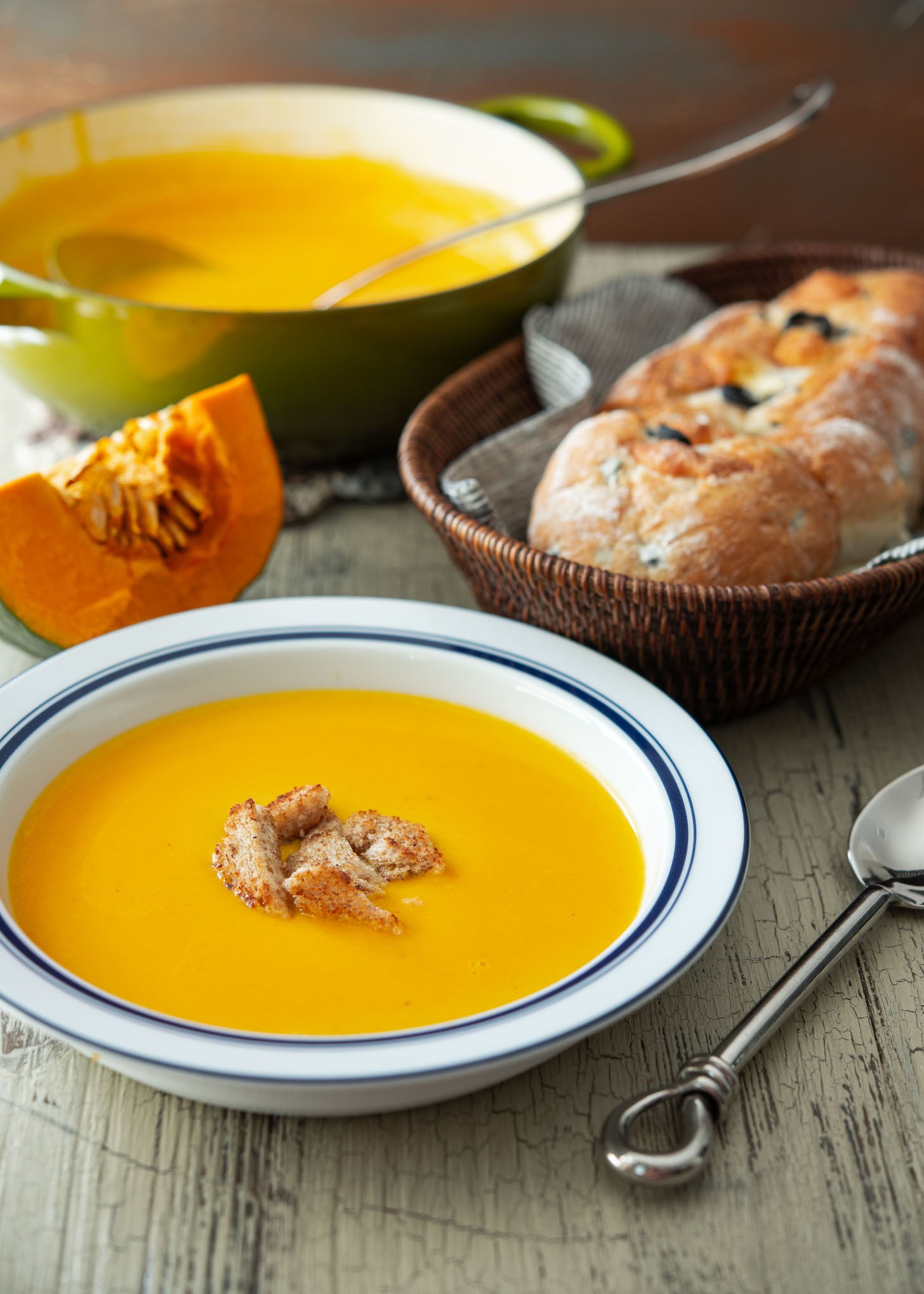

Tips for Making Kabocha Soup
Whipping up kabocha soup is straightforward and simple, but handling the hard, raw kabocha skin requires some attention. Here are a few handy tips for managing that tough exterior:
- Peel skin with Potato Peeler: Cutting the squash into smaller wedges simplifies the peeling process. While a sharp knife can do the job, a potato peeler is actually super effective and safer for this task.
- Soften in the Microwave: Dealing with a smaller kabocha? Pop the whole kabocha squash in the microwave for a quick 3-minute zap. This softens the skin, making it easier to cut through. Just remember, it does cook the flesh slightly, too.
- Cook with the Skin On: If you’re all about that bright, vibrant orange soup, you’ll want to peel off the skin. However, if it’s not a big deal for you, go ahead and toss the skin right into the pot! Just halve the kabocha, scoop out the seeds, and dice the rest up.
- Bonus: you’re keeping all the extra nutrients from the skin!
- Maintain the temperature: While simmering the soup, keep the heat at medium-low to prevent the milk from curdling.
- But don’t worry too much—if it does curdle, it’s not a big deal, as you’ll be blending everything into a smooth puree later on.
Ingredients
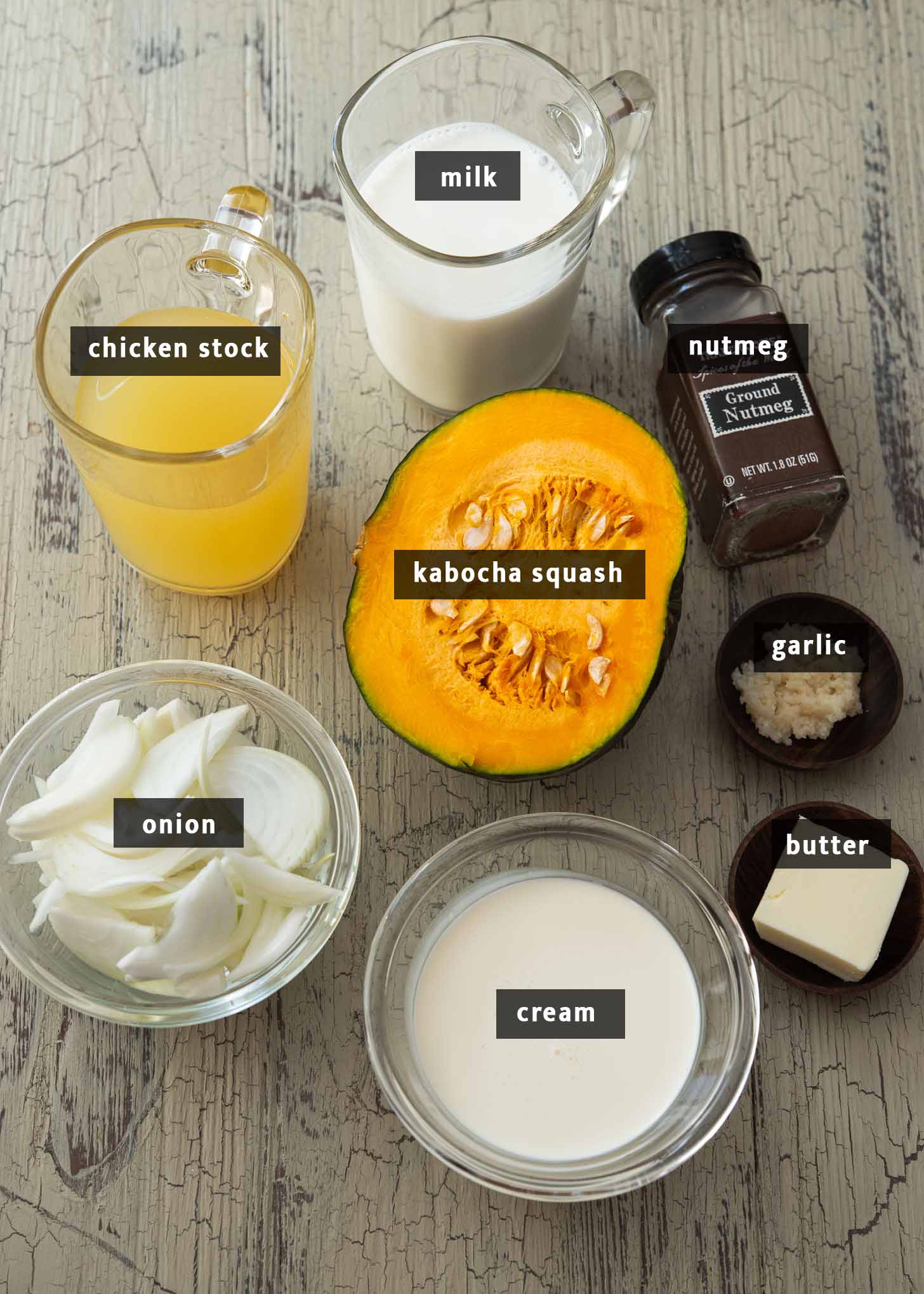

- Kabocha: Choose one that’s heavy for its size, with a deep green, matte skin. It’s okay if there are small scratches or blemishes, but steer clear of any with large soft spots or any signs of rot.
- A flat-bottomed kabocha is often preferred as it’s likely to have more flesh and less space taken up by seeds.
- Butter: This adds a rich, creamy dimension to the soup, helping to meld the flavors together beautifully.
- Onion and Garlic: Essential aromatics that provide a savory depth to your soup.
- Chicken Stock: Adds depth and richness to the soup, enhancing the overall taste
- Milk and Cream: These contribute to the soup’s creamy texture. For an even richer soup, use full-fat versions.
- You can also use coconut milk for a dairy-free option!
- Nutmeg: Just a pinch can add a subtle warmth and complexity to the soup’s flavor profile.
- Salt and Pepper: Essential for bringing all the flavors together; season to taste.
- Garnish: Croutons or chopped nuts add a delightful crunch, while a sprinkle of parsley will offer a fresh, colorful contrast.
Ingredient Adaptations
No kabocha? No problem! You can easily substitute it with butternut squash or acorn squash, which is just as delicious.
If you’re aiming for a vegan or vegetarian version of the dish, simply swap out the butter for olive oil to maintain that rich flavor. Also, replace the chicken broth with vegetable stock for a plant-based alternative.
As for the dairy, coconut cream and milk make fantastic substitutes, providing that creamy texture without the lactose.
How to cook Kabocha Squash Soup
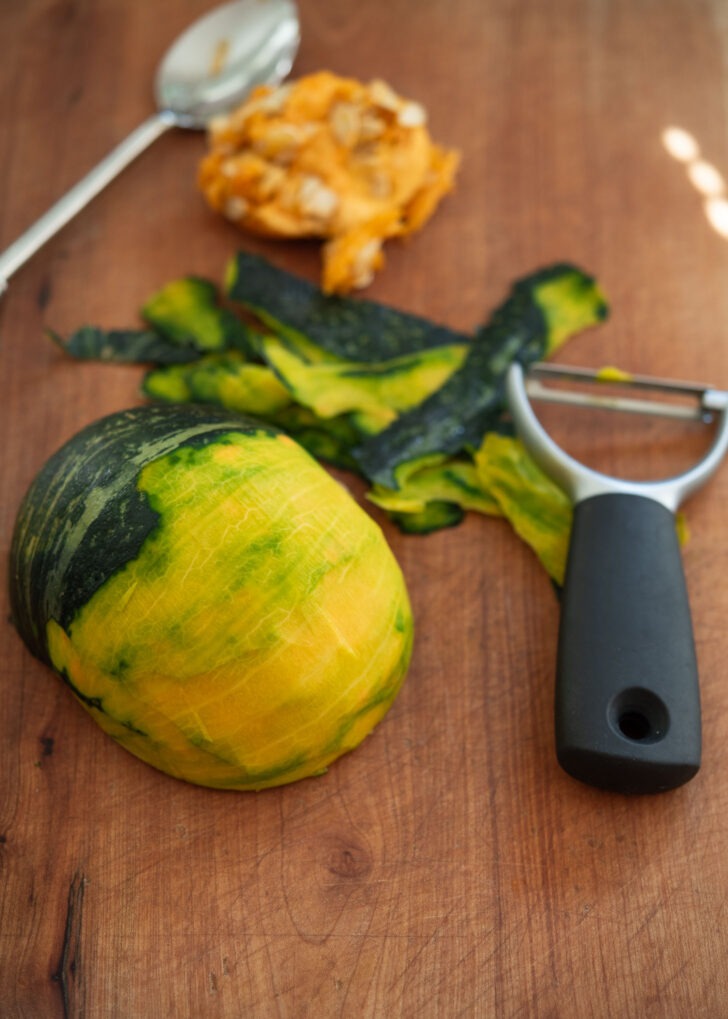

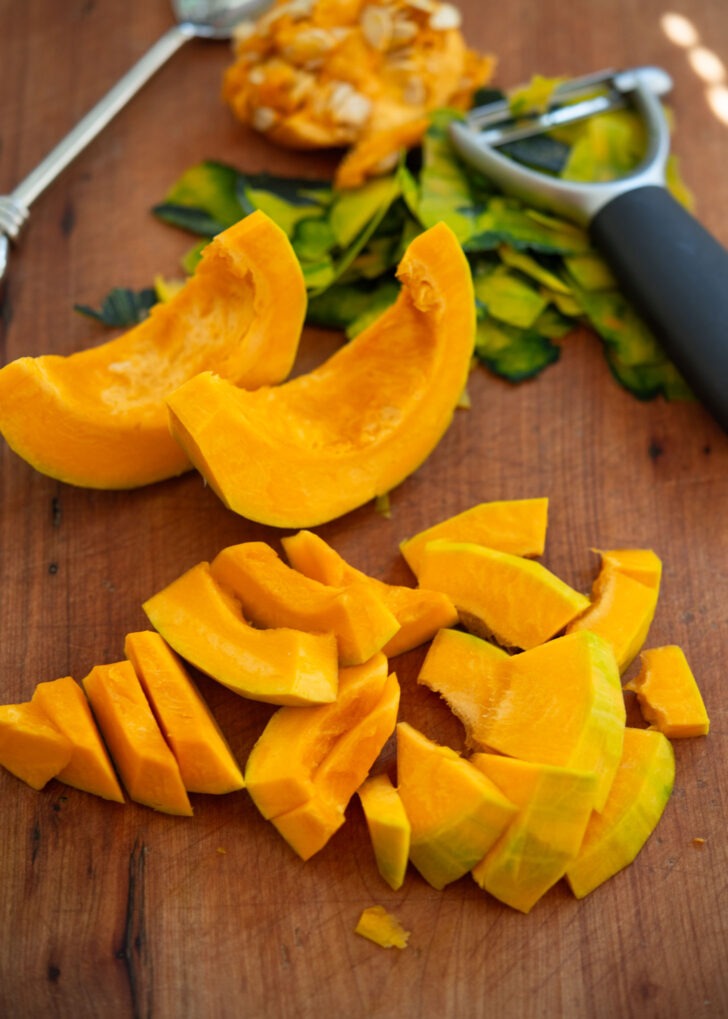

Step 1. Prepare the Kabocha
- Start by peeling the kabocha squash and scooping out the seeds.
- Then, cut it into wedges followed by slicing these into thin pieces with a sharp knife. The thiner the pieces, the quicker they cook.
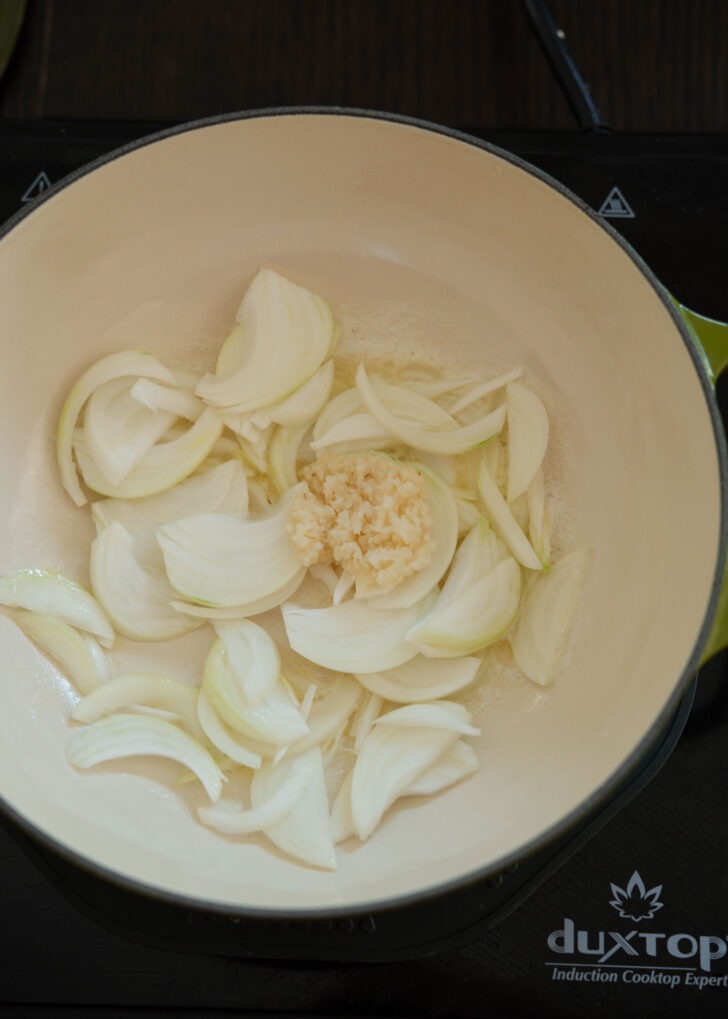

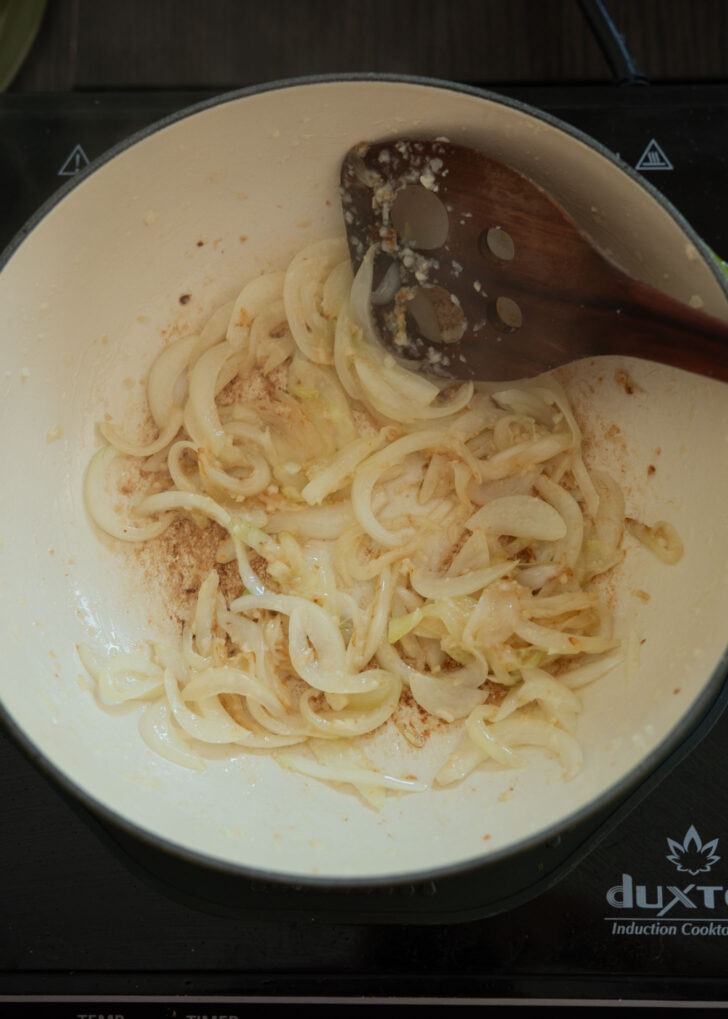

Step 2. Sauté Onions and Garlic
- In a soup pot, melt some butter over medium heat. Toss in the onion and garlic along with a couple of pinches of salt.
- Sauté the mix until it’s lightly browned, which should take about 3 minutes.
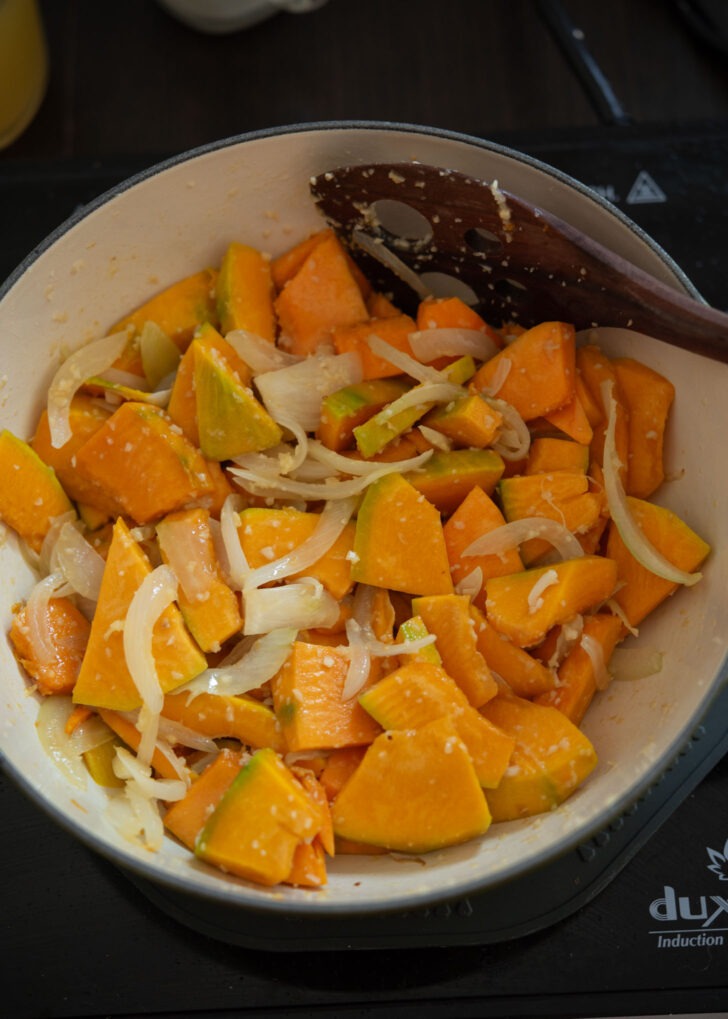

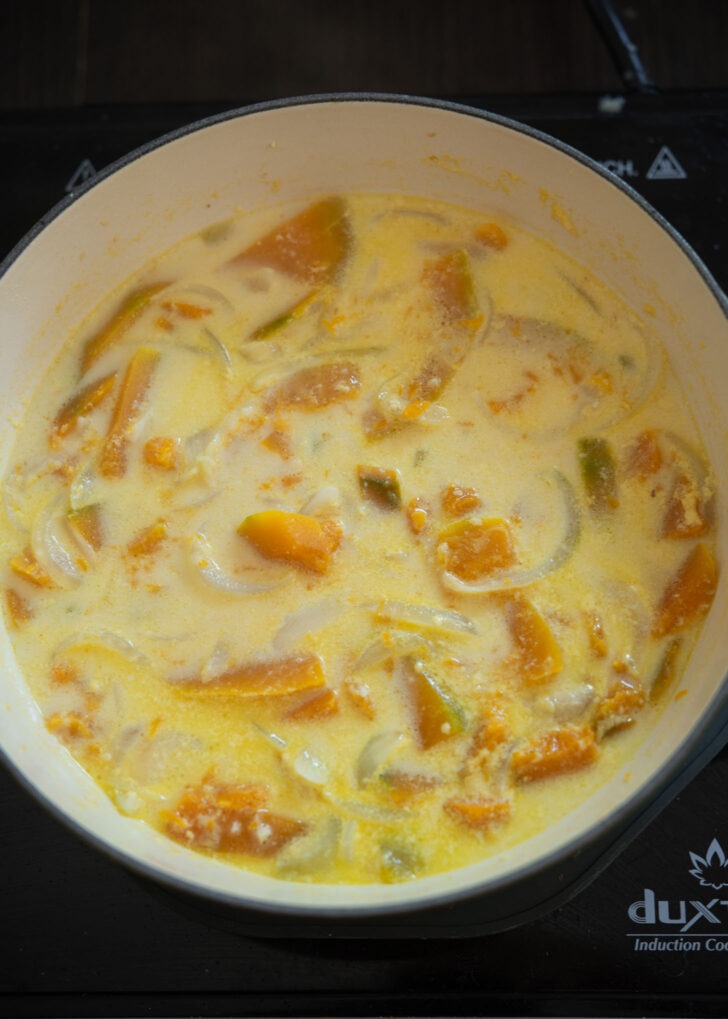

Step 3. Simmer the Soup
- Add the kabocha pieces and give them a good toss.
- Pour in the chicken stock and milk. Turn to medium-low heat, let everything simmer gently for around 8-10 minutes, or until the kabocha is tender.
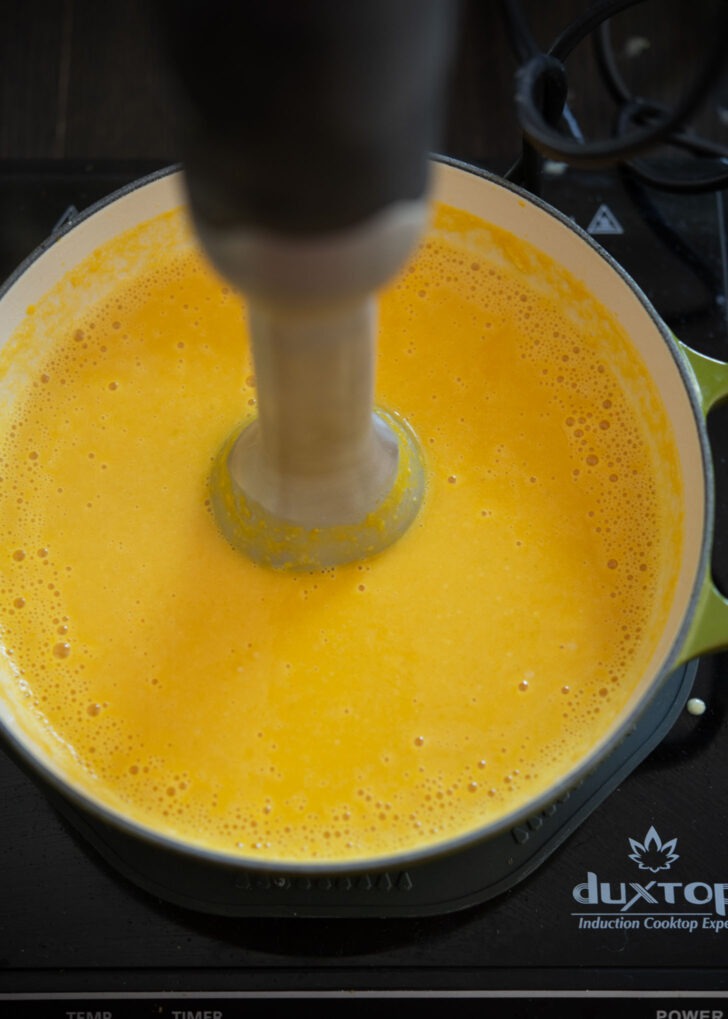

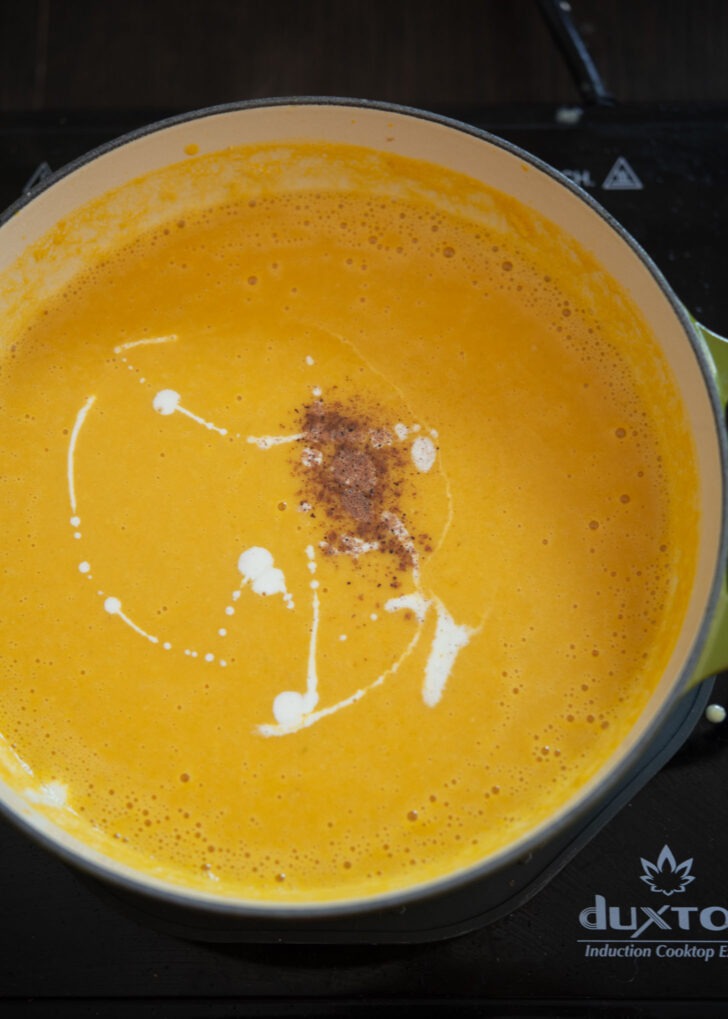

Step 4. Blend it Up
- Use an immersion blender or transfer the mixture to a high speed blender. Whizz everything up until you’ve got a smooth soup.
Step 5. The Final Touches
- Stir some cream into the soup, warming it up again if needed. Add a dash of nutmeg, salt and pepper to taste.
- For that extra flair, drizzle more cream on top of soup and garnish with croutons or a sprinkle of parsley.
Step 6. Serve and Enjoy
- Dish up your creamy soup while it’s warm. It pairs beautifully with a side of toasted bread for some extra coziness.
Storage Suggestion
If you have any soup left over, just transfer it to an airtight container and keep it in the refrigerator for up to a week.
When you’re ready to enjoy it again, you can easily reheat it in the microwave or warm it up in a pot on the stove until it’s nice and hot. Simple and delicious!
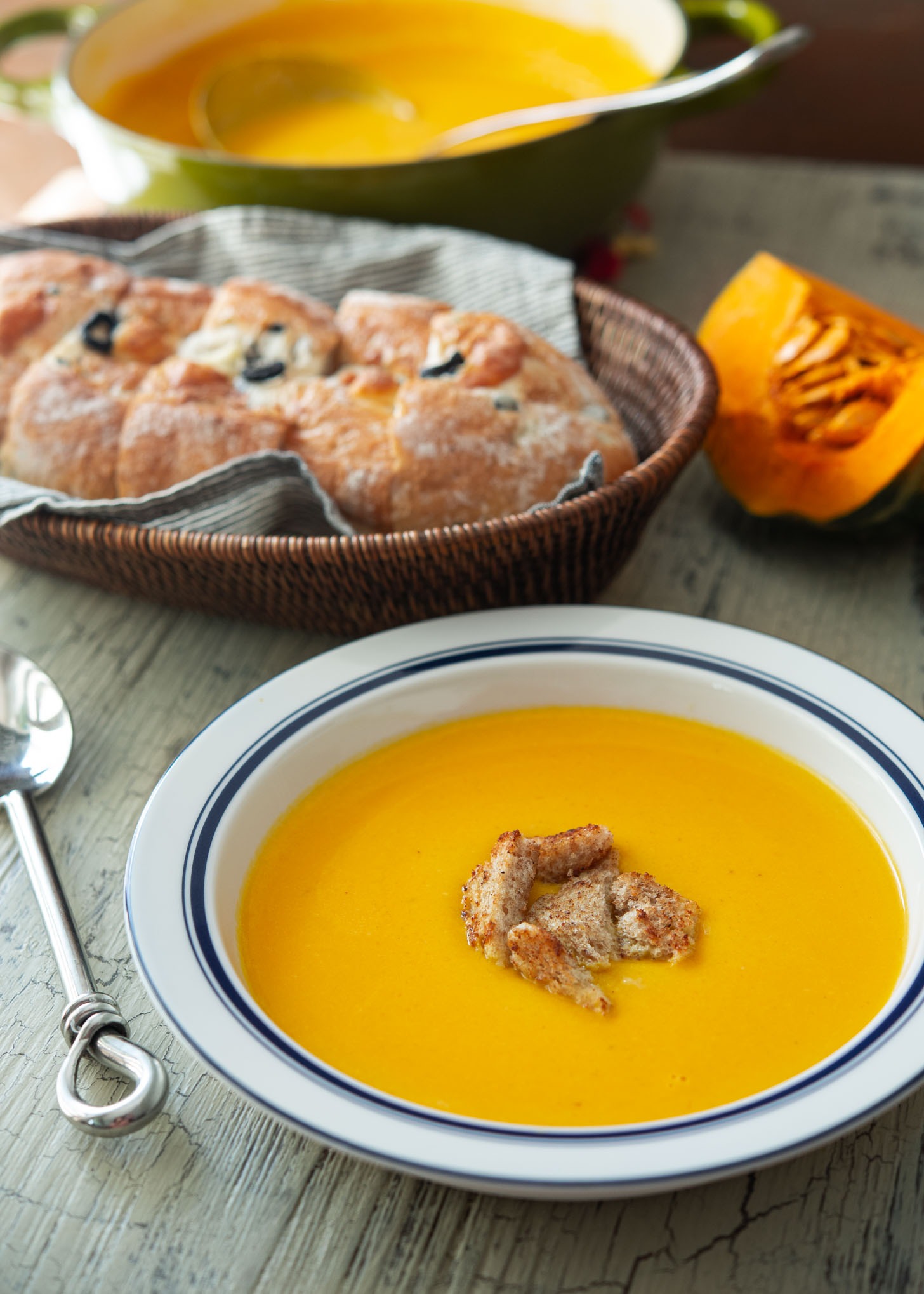

FAQs
What can you make with kabocha squash?
Kabocha is not only great for soup recipes, but it’s also super versatile and can be transformed into a variety of tastydishes.
Consider whipping up some Korean pumpkin porridge or Savory pumpkin pancakes. It’s also a star ingredient in pumpkin rice donuts and makes for a delightful kabocha salad. Enjoy experimenting!
Is it possible to freeze squash soup?
Absolutely, you can freeze kabocha squash soup! Just let the soup cool completely, then store it in a freezer-safe container. It’s best to use it within 2-3 months for optimal taste.
Are kabocha seeds edible?
Yes, kabocha seeds are edible! Similar to pumpkin seeds, kabocha seeds can be roasted for a crunchy snack. Just clean the seeds, toss them with a little oil and your choice of seasonings, and then roast them until they’re golden and crisp. They’re not only tasty but also a good source of nutrients like fiber, protein, and various minerals.
More Soup Recipes
Love this recipe? Rate it and share your experience in the comments below! On Instagram? Tag me to showcase your creation. For more delicious recipes, subscribe to our newsletter!


Creamy Kabocha Squash Soup
Kabocha squash soup is easy to make, earning its place as a perfect fall soup recipe. It’s creamy, has a hint of nutmeg, and goes great with crusty bread. You can also easily adapt it vegetarian or lactose-free.
- 1 lb (450 g) kabocha squash
- 2 tbsp butter
- 1/2 onion, thinly sliced
- 2 cloves garlic, minced
- 1-1/4 cup chicken stock, low sodium preferred
- 1 cup milk, full-fat preferred
- 1/4 cup heavy whipping cream
- 2 pinches nutmeg
- salt and pepper, to taste
To garnish
- croutons, chopped nuts, or parsley
-
Start by peeling the kabocha squash and scooping out the seeds. Then, cut it into wedges followed by slicing these into thinner pieces. The thinner the pieces, the quicker they cook.
-
In a soup pot, melt some butter over medium heat. Toss in the onion and garlic along with a couple of pinches of salt. Sauté the mix until it’s lightly browned, which should take about 3 minutes.
-
Add the kabocha pieces and give them a good toss. Pour in the chicken stock and milk. Turn to medium-low heat, let everything simmer gently for around 8-10 minutes, or until the kabocha is tender.
-
Use an immersion blender or transfer the mixture to a high speed blender. Whizz everything up until you’ve got a smooth soup.
-
Stir the cream into the soup, warming it up again. Add a dash of nutmeg, salt and pepper to taste. For that extra flair, drizzle more cream on top of soup and garnish with croutons or a sprinkle of parsley. Serve hot with crusty bread.
No kabocha? You can easily substitute it with butternut squash.
Calories: 161kcal, Carbohydrates: 17g, Protein: 6g, Fat: 9g, Saturated Fat: 5g, Polyunsaturated Fat: 1g, Monounsaturated Fat: 2g, Cholesterol: 27mg, Sodium: 126mg, Potassium: 603mg, Fiber: 2g, Sugar: 8g, Vitamin A: 1882IU, Vitamin C: 16mg, Calcium: 133mg, Iron: 1mg

